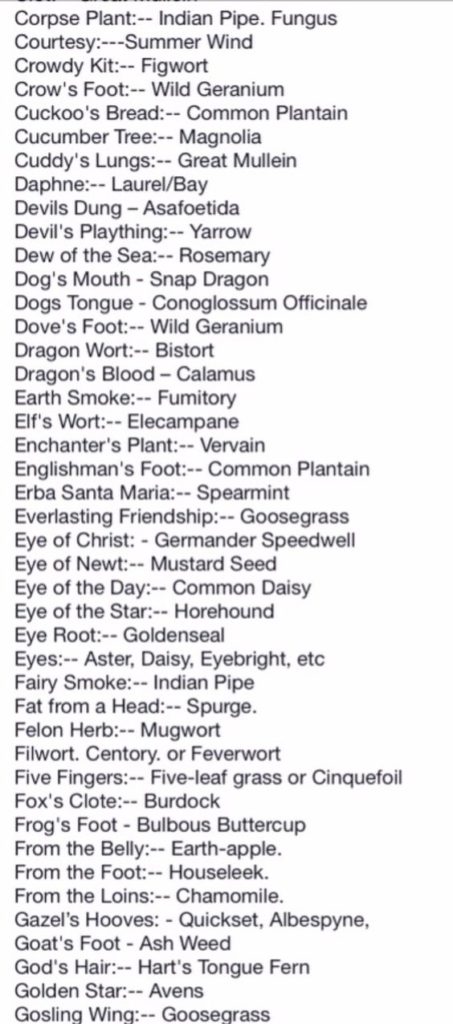
Today, with the massive pool of information that the internet offers, we can find details about any and every subject in minutes. This freedom of knowledge distribution, however, would have had disastrous consequences in the Middle Ages. The details of ancient medicine, alchemy, and folk medicine used to be classified knowledge and the recipes had to be kept a secret to prevent misuse. Hence, the practitioners came up with interesting names that would sound like animal parts but were secret code names of the plants they would use. These names were derived from the general appearance of the plant or a part of it, its effect in healing or spellcasting, or from mythology.

Below is a list of some intriguing ancient names found in folklore and the herb they represent –
1. Aaron’s Rod, Goldenrod, Goldruthe – Solidago
2. Absinthe, Blood of Hephaistos, Wormwood, Crown for a King – Artemisia
3. Adder’s Fork, Adder’s Tongue – The Ophiglossum plant gets this name as its spore-containing stalk has an appearance similar to the tongue of a snake.
4. Ague Root, Ague Grass, Backache Root, Black Root, Colic Root, Crow Corn – Aletris
5. Alison, Sweet Alyssum – Alyssum
6. Angel Food, Archangel – Angelica blooms usually around Archangel Michael’s feast day. He is said to have appeared in a vision and propagated the protective powers this plant has in warding off evil.
7. Ass’s Ear – The Comfrey is called so because of its large hairy leaves that resemble the ears of an ass.
8. Ass’s Foot, Bull’s Foot – Colt’s foot or Tussilago
9. Auld Man’s Bells, Old man’s bells – The Wood Hyacinth gets this interesting name from its association to the devil and death. ‘Auld man’ is another name for the Devil in Scottish lore and they were often planted near graves. It was considered ominous to pluck its flowers.
10. Bat flower, Bat whiskers, devil flower – Tacca chantrieri
11. Bat’s Wool – Any short green colored moss
12. Bear’s Grape – Uva-ursi or Bearberry
13. Bear weed, Yerba santa, Holy Herb – Eriodictyon californicum
14. Beggar’s Buttons, Lappa, Thorny Burr, Happy Major – Greater burdock
15. Beggar’s Tick, Cobbler’s pegs, Spanish needle – Biden plants
16. Bloody Finger, Dead Man’s Bells, Dead Man’s Thimbles, Witch’s Gloves, Fairy’s Finger – Foxglove
17. Brains – Solidified gum from the bark of Cherry
18. Calves’ Snout, Weasel’s Snout – Snapdragon
19. Candlemas Maiden, Candlemas Lilies – Snowdrop
20. Clear-Eye – The Clary Sage plant is known thusly because of its efficacy in eye cleansing and in treating eye problems such as poor vision or ulcers.
21. Corpse Candles, Clot, Cuddy’s Lungs – Mullein
22. Corpse Plant – Titan arum; this plant is called so because it emits a strong odor similar to that of decaying meat or a ‘rotting corpse’.
23. Crow Foot, Red Robin – Wild Geranium
24. Crowdy Kit, Fiddlewood – The Figwort plant gets this name where the ‘Kit’ also means fiddle because if you rub two of its branches, it makes a noise similar to a fiddle.
25. Devil’s Apple, Devil’s Trumpet – Datura
26. Devil’s Eye – Henbane, Periwinkle
27. Devil’s Flower – Crocosmia
28. Devil’s Milk – Euphorbia
29. Devil’s Porridge, Devil’s Bread – The Hemlock plant obtains these names due to its highly toxic nature. It has a very high concentration of neurotoxins and was used in Ancient Greece as a death sentence for prisoners.
30. Devil’s Plaything, BloodWort, Death Flower, Devil’s Nettle – Being used excessively in exorcism rituals by Christians, the Yarrow is said to bring out and drive away evil.
31. Dog Fennel – The Anthemis plant is called so because of its resemblance to the fennel plant. The ‘Dog’ part of its name comes from its use as an insect and flea repellant outside dog kennels.
32. Dog Grass, Couchgrass – Agropyrum
33. Dog’s Mouth, Toad’s Mouth, Lion’s Mouth – Snapdragon
34. Dog’s Tail – Crested dog’s-tail, Cynosurus
35. Dog’s Tongue, Hound’s Tongue – Conoglossum officinale
36. Dragonwort, Felon Herb, Old Man, St. John’s Plant, Witch Herb, Mugwort, Little Dragon – Tarragon
37. Dragon’s Scales – Leaves of the Bistort plant
38. Duck’s Foot, Devil’s Apple, Mandrake – Mayapple
39. Ear of a Goat, Goatweed – St. John’s Wort
40. Enchanter’s Plant, Herb of Grace – The Vervain plant is named so because of its special powers to enhance the action of any other herb when used in combination during spellcasting. It is believed to have obtained its powers after being used to heal the wounds of Christ on the crucifix.
41. Erba Santa Maria, Yerba Santa, Hook and arm – Balsam leaf, Mint geranium, Spearmint
42. Eye of the Day, Day’s Eye – Daisy
43. Eye of Newt – The seed of the Mustard plant gets this name because of its appearance is similar to the eye of a newt.
44. Eye Root – The Goldenseal plant was used by Native Americans to concoct eye drops for the treatment of eye problems such as red, sore, or irritated eyes.
45. Fairies’ Horses – The Ragwort plant has a very interesting story behind this name. It is said that a man named Thomas, while crossing through a field full of Ragworts, discovered that it is full of fairies who plucked a flower each and transformed into horses. It is believed that fairies use the Ragwort flowers for this purpose even today.
46. Fairy Bells, Wood Sour, Cuckoo’s Meat – Wood Sorrel
47. Fairy Cup, Key of Heaven – Cowslip
48. Fat from a Head – This is the old name of the Spurge plant. Remarkably, its scientific name Euphorbia Leucocephala means ‘Well fed white head’ in Greek.
49. Filwort, Feverwort, Lesser Centaury, Minor Centaury – Centaury
50. From the Belly – Jerusalem artichoke, Earth apple
51. Goat’s Leaf – This is the old name for the Honeysuckle plant. It is interesting to note that the Honeysuckle family is scientifically named Caprifoliaceae, a fusion of the Latin words ‘Capri’ meaning goat and ‘folium’ meaning leaf.
52. Golden Star, Harefoot – Avens
53. Graveyard Dust, witch’s candles – The Mullein gets this name as it grows well-spaced in dry soil and burns like a candle when dipped in oil.
54. Hair of Venus – The Ancient Romans were fascinated by the Maidenhair Fern because of its beautiful silvery glimmer when dipped in water and its waterproof, hydrophobic nature when removed. Roman mythology said it was a representation of Venus arising from the sea foam, hence imparting the name ‘Maidenhair’ and ‘Hair of Venus’.
55. Hag’s Taper, Jacob’s Staff, Jupiter’s Staff, Jacob’s Staff, Jupiter’s Staff – Great Mullein
56. Hundred Eyes, Blue Buttons, Devil’s Eye – Periwinkle
57. Indian Dye – The American Indians used Goldenseal in making dyes and in medicine, which is how it got this folk name.
58. Joy of the Mountain – Oregano or Marjoram
59. Kronos’ Blood – Sap of the Cedar tree
60. Lady’s Meat – Flower of the Mayflower plant
61. Lady’s Slipper, Bleeding Heart, Slipper Root – American Valerian
62. Lamb’s Ears, Wooly Betony – Stachys
63. Love in Idleness – The Pansy has a very fascinating story behind this name. It is said that once Cupid missed an arrow and it hit the pansy plant instead. As Cupid is the God of Love, the pansy imbibed the power to act as a potent ingredient for a love potion. The ‘Idleness’ part of its name comes from its use in conjuring idleness or evil spells.
64. Love Lies Bleeding – The spikes of blood-red flowers give the Amaranth plant this name.
65. Man’s Health – The extracts of Ginseng have been extensively used in history to treat male sexual health problems like erectile dysfunction. The importance of this in male overall health lends it this name.
66. Mistress of the Night, Night Queen – The Tuberose plant emits a strong, sweet smell after sunset, creating a mood for love. Its oil is also used as an aphrodisiac, hence giving it these names.
67. Newt`s Tail – The shape of the flowers of the Saururus plant is in the shape of a Newt’s tail. This resemblance is the reason behind its name in folklore.
68. Organ Tea – The essence of Pennyroyal has been extensively used in history to treat all kinds of ailments. It was also used as an abortifacient, which means that it can induce abortions. Its overall goodness for health gives it this name. However, today it is considered highly toxic and is no longer in use for healing.
69. Pantagruelian – Pantagruel, the son of Gargantua, is said to have carried the Marijuana plant (which he named Pantagruelian) along with him in his journeys. Today, the term ‘Pantagruelism’ refers to drunken foolish behavior.
70. Poor Man’s Weatherglass, Shepherd’s Weatherglass – The flowers of the Scarlet pimpernel plant open exclusively under the sunshine, hence being an accurate representation of the weather and lending it this name.
71. Queen of the Night – The flowers of the Vanilla Cactus plant start blooming at 10 pm and are in full bloom by midnight, but wither by sunrise. When in bloom, it emits a beautiful fragrance similar to the vanilla flower. These features give the plant its unique name.
72. Robin-Run-in-the-Grass, Sticky Willow – Known by several other names such as Robin-run-the-hedge and Cleavers, the Goosegrass plant has been used in history to treat skin ailments such as minor burns, rashes, wounds, and stings.
73. Thor’s Helper – The old name of the Rowan plant has an interesting mythological backstory. It is said that when Thor was battling the giant Geirrodr, his daughter tried to drown him in the river. Thor was almost swept away by the river currents until he grabbed a branch of the Rowan plant and escaped the torrents.
74. Tree of Heaven – Varnish tree
75. Unicorn’s Horn – Blazing star
76. Weazel Snout – Silverfrost, Golden Dead Nettles
77. Witch’s Asprin – The bark of the Willow plant has been used in medicine for many centuries. Its folklore name comes from its acetylsalicylic acid content, which is the main compound in aspirin.
78. Witch’s Hair, Devil’s Hair, Hairweed – Cuscuta or Dodder
79. Wolf Foot, Water Horehound – Sweet bugleweed
80. Wolf’s Hat, Monk’s Hood, Wolfsbane – Aconite
81. Wolf’s Milk – Spurge
Want to learn more about herbs, herb gardening, and uses in cooking? Check more out here!







